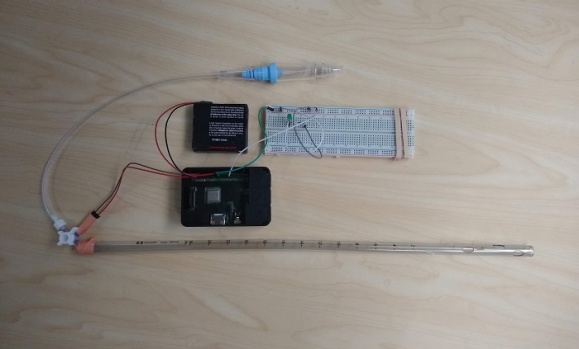News
» Go to news mainEngineering Capstone Project supporting patients with collapsed lungs

A group of students from Dalhousie’s Department of Mechanical Engineering are developing a novel device to help patients who have experienced a pneumothorax, also known as a collapsed lung.
The medical condition can occur when air leaks from the lungs and enters the pleural cavity. As air builds up, it causes the nearby lung to collapse on itself.
Treatment options include removal of the air from the pleural cavity with a needle and syringe or inserting a hollow plastic chest tube between the ribs and attaching it to a suction device. The tube is designed to continuously remove air from the pleural cavity until the lung has re-expanded and healed. This may take several days and patients are often discharged from the hospital during that time and asked to return at a later date to remove the tube.
The problem, says Dylan Ormiston, a 2020 mechanical engineering graduate, is that when patients return to the hospital to have the tube removed, the pressure inside the pleural cavity has not yet normalized.
“Right now, the only way to verify that the chest tube is ready to come out is to take an x-ray and confirm that the lung has re-expanded, which can be very time consuming and costly for a hospital,” says Ormiston, “The decision of when to remove the chest tube is an inexact science. Logistically, this poses a challenge for surgeons. Should the patient stay and occupy a hospital bed, or should they be sent home and for how long? It’s not uncommon for returning patients to be sent home again because it’s too early to remove the tube.”
To combat the problem, Ormiston teamed up with three of his classmates this year, Laura Flick, Carli Spears and Brian MacGillivray, to create a device that will accurately measure expelled air from a patient’s pleural cavity, signaling to surgeons when they can safely remove the tube from the patient’s chest. It’s the first of its kind around the world.
The project was part of this year’s Dalhousie University Capstone Design course; an opportunity for senior year students within the Faculty of Engineering to collaborate with local industry partners on real-world problems.
Working alongside Dr. Kevin Spencer, President and Founder of KDS Medical Engineering Inc., and an Emergency Medicine Physician at Dartmouth General Hospital, Ormiston and his team consulted with thoracic surgeons to get a better sense of the challenges they face in dealing with current practices pertaining to patients with a collapsed lung.
“We’ve created a device that can measure the air pressure leaving a patient with an alert system ready in the event of a dangerous increase in pleural cavity pressure, known as a tension pneumothorax,” says Ormiston. “One of the biggest challenges thus far has been getting a sensor sensitive enough to detect the desired pressure changes.”
He says that the other issue is determining the appropriate pressure ranges that will cue the device to signal when the chest tube can be safely removed or when a potentially severe pressure buildup has occurred.
“The air pressure can be very different between individuals, so it’s challenging to decide what range is appropriate,” says Ormiston. “We’re measuring the pressure of the pleural cavity, and there are no universally-accepted values for it. So, we’re basing our numbers on what we estimate is normal for a healthy lung and creating a range of pressures that apply to most individuals.
Ormiston’s teammate, Carli Spears has experience with the challenges patients face with chest tubes.
While in high school, her older brother suffered a collapsed lung, requiring the insertion of a chest tube.
“He was in the hospital for a little over a week. When they thought it (the lung) was healed, they proceeded to take the tube out and the lung re-collapsed” says Spears. “So he had to have surgery done to fix that.”
She says the struggle of not knowing if the lung has healed and if the chest tube should be removed can cause a lot of stress and anxiety for patients and she hopes her team’s new device can help alleviate some of those challenges.
Recent News
- Could UV LEDs be the future of wastewater treatment?
- Transforming plastic waste into 3D printing material
- 2024 Capstone Poster Expo
- Brewing Sustainability: Dalhousie’s Capstone team utilize algae for carbon capture project
- Capstone team helps local company reduce carbon footprint
- Engineering Programs & AU Open‑House
- An international student’s perspective on Canada’s Iron Ring tradition
- Crafting a legacy: Ispeeta Ahmed’s Journey as a Schulich Scholar Leader
